Designing a Distribution System for Grocery Supply Chain Report
VerifiedAdded on 2023/01/16
|11
|3066
|40
Report
AI Summary
This report focuses on designing a distribution system for a grocery supply chain. It begins with a literature review of issues in supply chains, logistics networks, and distribution systems, highlighting cost increases, complexity, and volatility. The report then designs a four-level logistics network for grocery distribution, utilizing a continuous flow model and demand forecasting. It addresses challenges like increased logistics costs, communication issues, and infrastructure problems. The network's elements, features, and limitations are discussed, including the use of demand forecasting and the potential for inaccuracies. The report suggests using past order data and linear forecasting models to improve accuracy. Finally, a managerial report is created to rationalize the developed network, providing insights into its practical application and effectiveness.
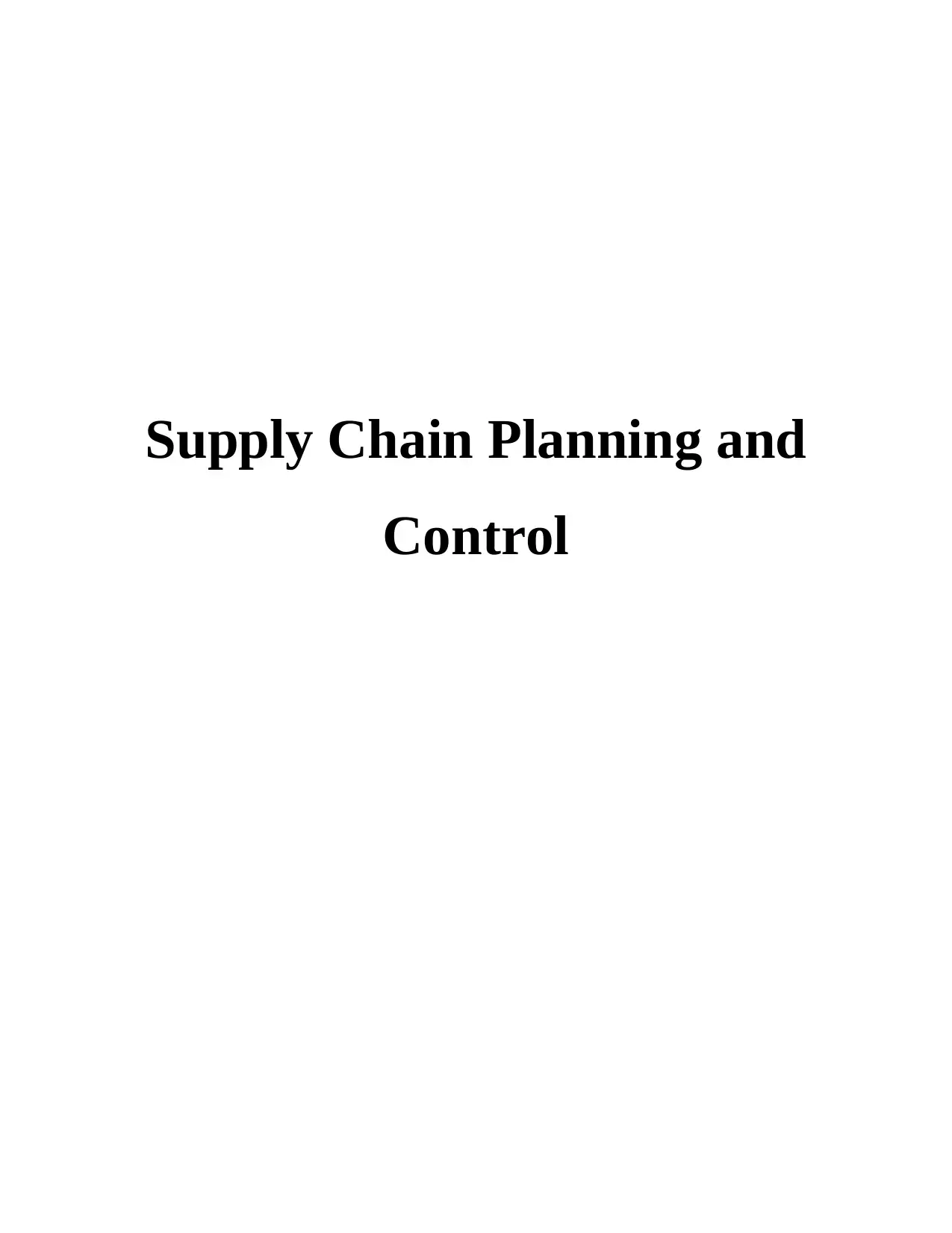
Supply Chain Planning and
Control
Control
Paraphrase This Document
Need a fresh take? Get an instant paraphrase of this document with our AI Paraphraser
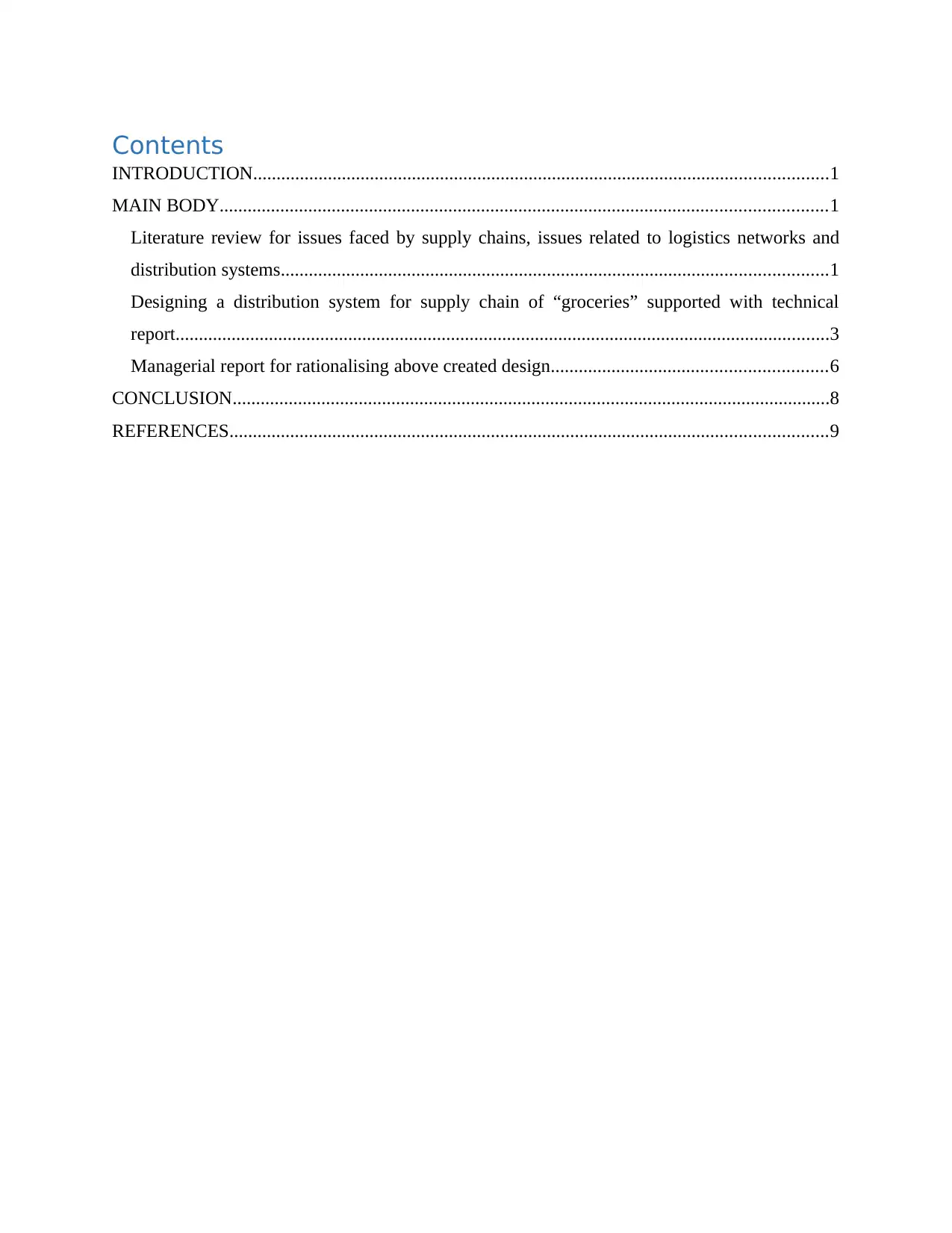
Contents
INTRODUCTION...........................................................................................................................1
MAIN BODY..................................................................................................................................1
Literature review for issues faced by supply chains, issues related to logistics networks and
distribution systems.....................................................................................................................1
Designing a distribution system for supply chain of “groceries” supported with technical
report............................................................................................................................................3
Managerial report for rationalising above created design...........................................................6
CONCLUSION................................................................................................................................8
REFERENCES................................................................................................................................9
INTRODUCTION...........................................................................................................................1
MAIN BODY..................................................................................................................................1
Literature review for issues faced by supply chains, issues related to logistics networks and
distribution systems.....................................................................................................................1
Designing a distribution system for supply chain of “groceries” supported with technical
report............................................................................................................................................3
Managerial report for rationalising above created design...........................................................6
CONCLUSION................................................................................................................................8
REFERENCES................................................................................................................................9
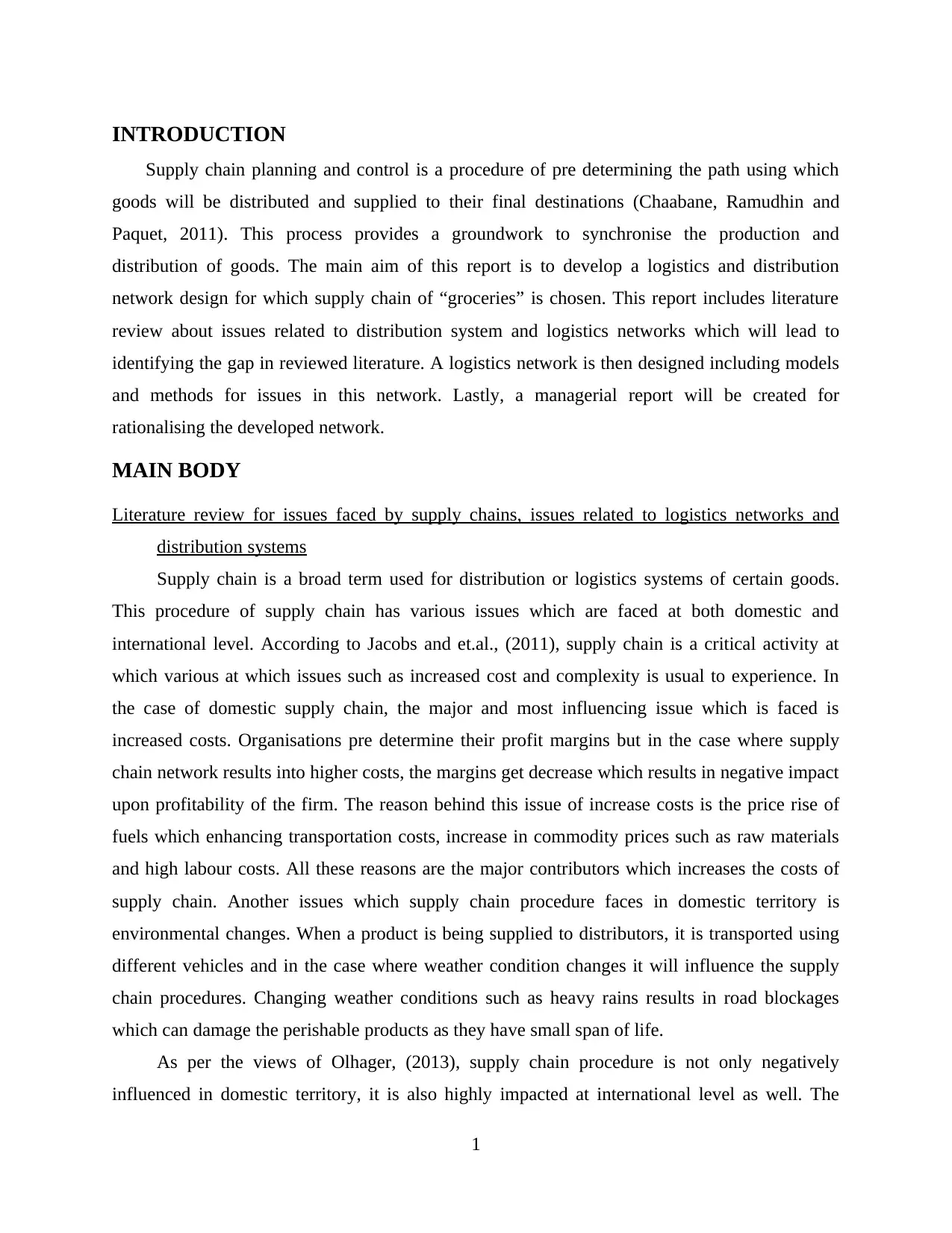
INTRODUCTION
Supply chain planning and control is a procedure of pre determining the path using which
goods will be distributed and supplied to their final destinations (Chaabane, Ramudhin and
Paquet, 2011). This process provides a groundwork to synchronise the production and
distribution of goods. The main aim of this report is to develop a logistics and distribution
network design for which supply chain of “groceries” is chosen. This report includes literature
review about issues related to distribution system and logistics networks which will lead to
identifying the gap in reviewed literature. A logistics network is then designed including models
and methods for issues in this network. Lastly, a managerial report will be created for
rationalising the developed network.
MAIN BODY
Literature review for issues faced by supply chains, issues related to logistics networks and
distribution systems
Supply chain is a broad term used for distribution or logistics systems of certain goods.
This procedure of supply chain has various issues which are faced at both domestic and
international level. According to Jacobs and et.al., (2011), supply chain is a critical activity at
which various at which issues such as increased cost and complexity is usual to experience. In
the case of domestic supply chain, the major and most influencing issue which is faced is
increased costs. Organisations pre determine their profit margins but in the case where supply
chain network results into higher costs, the margins get decrease which results in negative impact
upon profitability of the firm. The reason behind this issue of increase costs is the price rise of
fuels which enhancing transportation costs, increase in commodity prices such as raw materials
and high labour costs. All these reasons are the major contributors which increases the costs of
supply chain. Another issues which supply chain procedure faces in domestic territory is
environmental changes. When a product is being supplied to distributors, it is transported using
different vehicles and in the case where weather condition changes it will influence the supply
chain procedures. Changing weather conditions such as heavy rains results in road blockages
which can damage the perishable products as they have small span of life.
As per the views of Olhager, (2013), supply chain procedure is not only negatively
influenced in domestic territory, it is also highly impacted at international level as well. The
1
Supply chain planning and control is a procedure of pre determining the path using which
goods will be distributed and supplied to their final destinations (Chaabane, Ramudhin and
Paquet, 2011). This process provides a groundwork to synchronise the production and
distribution of goods. The main aim of this report is to develop a logistics and distribution
network design for which supply chain of “groceries” is chosen. This report includes literature
review about issues related to distribution system and logistics networks which will lead to
identifying the gap in reviewed literature. A logistics network is then designed including models
and methods for issues in this network. Lastly, a managerial report will be created for
rationalising the developed network.
MAIN BODY
Literature review for issues faced by supply chains, issues related to logistics networks and
distribution systems
Supply chain is a broad term used for distribution or logistics systems of certain goods.
This procedure of supply chain has various issues which are faced at both domestic and
international level. According to Jacobs and et.al., (2011), supply chain is a critical activity at
which various at which issues such as increased cost and complexity is usual to experience. In
the case of domestic supply chain, the major and most influencing issue which is faced is
increased costs. Organisations pre determine their profit margins but in the case where supply
chain network results into higher costs, the margins get decrease which results in negative impact
upon profitability of the firm. The reason behind this issue of increase costs is the price rise of
fuels which enhancing transportation costs, increase in commodity prices such as raw materials
and high labour costs. All these reasons are the major contributors which increases the costs of
supply chain. Another issues which supply chain procedure faces in domestic territory is
environmental changes. When a product is being supplied to distributors, it is transported using
different vehicles and in the case where weather condition changes it will influence the supply
chain procedures. Changing weather conditions such as heavy rains results in road blockages
which can damage the perishable products as they have small span of life.
As per the views of Olhager, (2013), supply chain procedure is not only negatively
influenced in domestic territory, it is also highly impacted at international level as well. The
1
⊘ This is a preview!⊘
Do you want full access?
Subscribe today to unlock all pages.

Trusted by 1+ million students worldwide
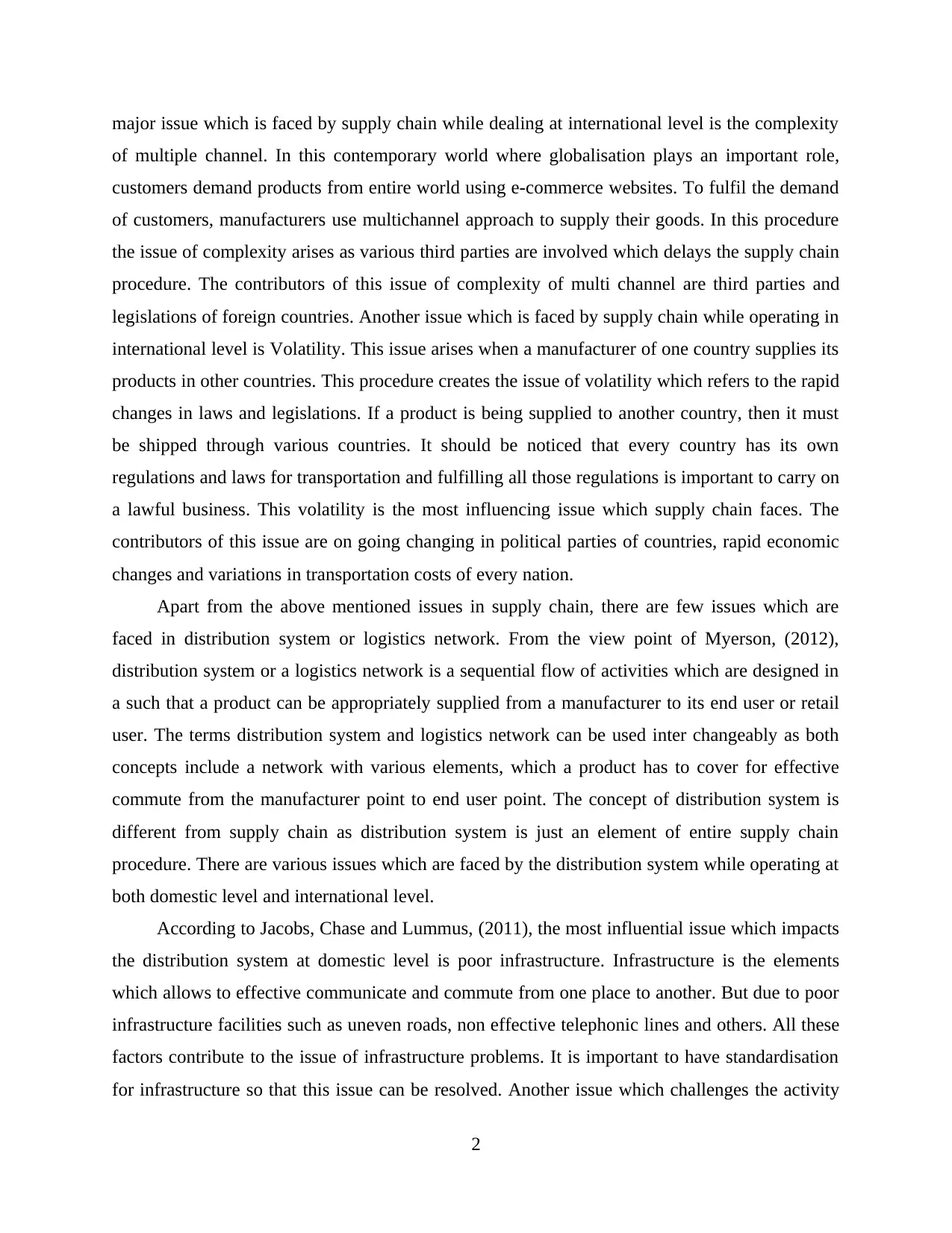
major issue which is faced by supply chain while dealing at international level is the complexity
of multiple channel. In this contemporary world where globalisation plays an important role,
customers demand products from entire world using e-commerce websites. To fulfil the demand
of customers, manufacturers use multichannel approach to supply their goods. In this procedure
the issue of complexity arises as various third parties are involved which delays the supply chain
procedure. The contributors of this issue of complexity of multi channel are third parties and
legislations of foreign countries. Another issue which is faced by supply chain while operating in
international level is Volatility. This issue arises when a manufacturer of one country supplies its
products in other countries. This procedure creates the issue of volatility which refers to the rapid
changes in laws and legislations. If a product is being supplied to another country, then it must
be shipped through various countries. It should be noticed that every country has its own
regulations and laws for transportation and fulfilling all those regulations is important to carry on
a lawful business. This volatility is the most influencing issue which supply chain faces. The
contributors of this issue are on going changing in political parties of countries, rapid economic
changes and variations in transportation costs of every nation.
Apart from the above mentioned issues in supply chain, there are few issues which are
faced in distribution system or logistics network. From the view point of Myerson, (2012),
distribution system or a logistics network is a sequential flow of activities which are designed in
a such that a product can be appropriately supplied from a manufacturer to its end user or retail
user. The terms distribution system and logistics network can be used inter changeably as both
concepts include a network with various elements, which a product has to cover for effective
commute from the manufacturer point to end user point. The concept of distribution system is
different from supply chain as distribution system is just an element of entire supply chain
procedure. There are various issues which are faced by the distribution system while operating at
both domestic level and international level.
According to Jacobs, Chase and Lummus, (2011), the most influential issue which impacts
the distribution system at domestic level is poor infrastructure. Infrastructure is the elements
which allows to effective communicate and commute from one place to another. But due to poor
infrastructure facilities such as uneven roads, non effective telephonic lines and others. All these
factors contribute to the issue of infrastructure problems. It is important to have standardisation
for infrastructure so that this issue can be resolved. Another issue which challenges the activity
2
of multiple channel. In this contemporary world where globalisation plays an important role,
customers demand products from entire world using e-commerce websites. To fulfil the demand
of customers, manufacturers use multichannel approach to supply their goods. In this procedure
the issue of complexity arises as various third parties are involved which delays the supply chain
procedure. The contributors of this issue of complexity of multi channel are third parties and
legislations of foreign countries. Another issue which is faced by supply chain while operating in
international level is Volatility. This issue arises when a manufacturer of one country supplies its
products in other countries. This procedure creates the issue of volatility which refers to the rapid
changes in laws and legislations. If a product is being supplied to another country, then it must
be shipped through various countries. It should be noticed that every country has its own
regulations and laws for transportation and fulfilling all those regulations is important to carry on
a lawful business. This volatility is the most influencing issue which supply chain faces. The
contributors of this issue are on going changing in political parties of countries, rapid economic
changes and variations in transportation costs of every nation.
Apart from the above mentioned issues in supply chain, there are few issues which are
faced in distribution system or logistics network. From the view point of Myerson, (2012),
distribution system or a logistics network is a sequential flow of activities which are designed in
a such that a product can be appropriately supplied from a manufacturer to its end user or retail
user. The terms distribution system and logistics network can be used inter changeably as both
concepts include a network with various elements, which a product has to cover for effective
commute from the manufacturer point to end user point. The concept of distribution system is
different from supply chain as distribution system is just an element of entire supply chain
procedure. There are various issues which are faced by the distribution system while operating at
both domestic level and international level.
According to Jacobs, Chase and Lummus, (2011), the most influential issue which impacts
the distribution system at domestic level is poor infrastructure. Infrastructure is the elements
which allows to effective communicate and commute from one place to another. But due to poor
infrastructure facilities such as uneven roads, non effective telephonic lines and others. All these
factors contribute to the issue of infrastructure problems. It is important to have standardisation
for infrastructure so that this issue can be resolved. Another issue which challenges the activity
2
Paraphrase This Document
Need a fresh take? Get an instant paraphrase of this document with our AI Paraphraser
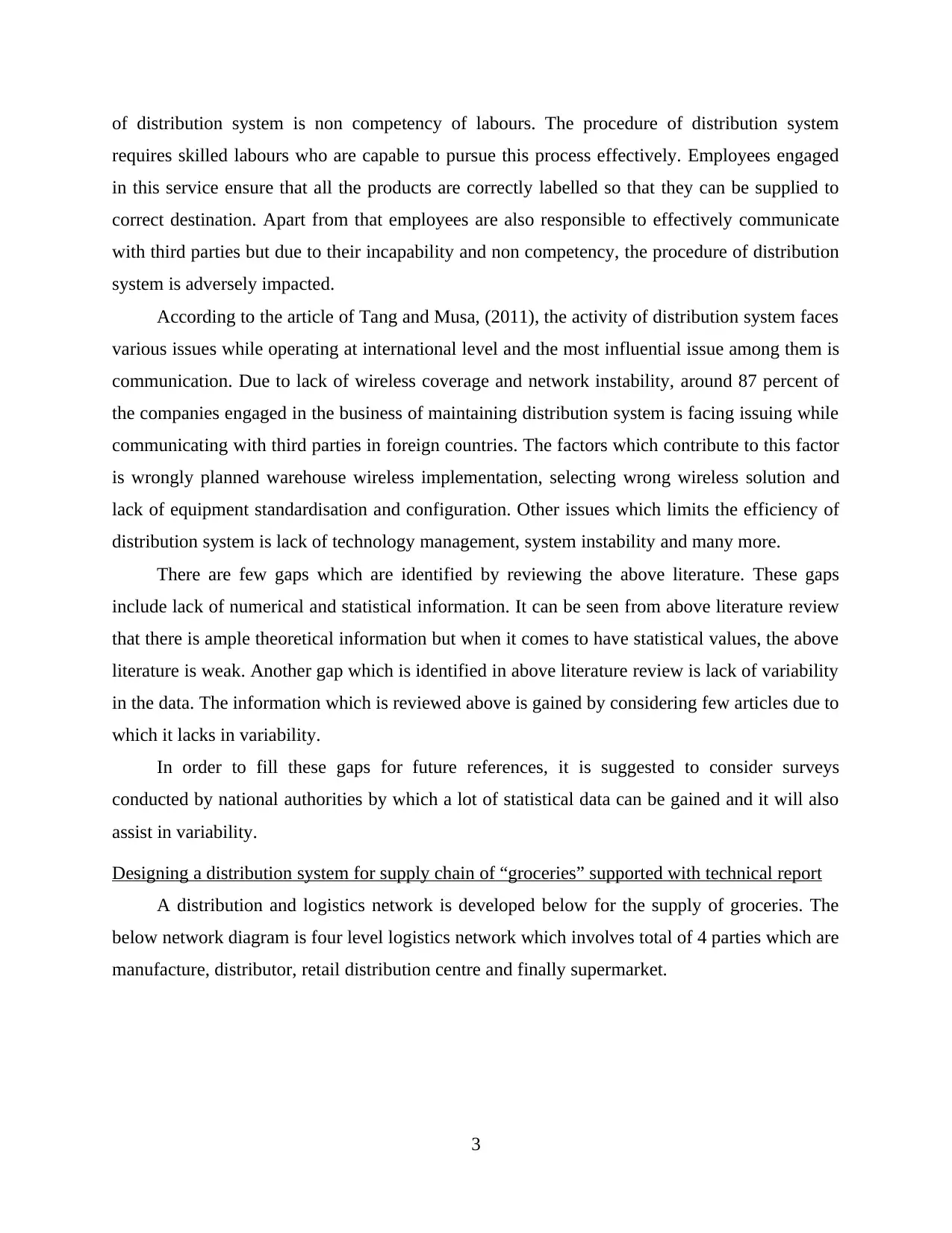
of distribution system is non competency of labours. The procedure of distribution system
requires skilled labours who are capable to pursue this process effectively. Employees engaged
in this service ensure that all the products are correctly labelled so that they can be supplied to
correct destination. Apart from that employees are also responsible to effectively communicate
with third parties but due to their incapability and non competency, the procedure of distribution
system is adversely impacted.
According to the article of Tang and Musa, (2011), the activity of distribution system faces
various issues while operating at international level and the most influential issue among them is
communication. Due to lack of wireless coverage and network instability, around 87 percent of
the companies engaged in the business of maintaining distribution system is facing issuing while
communicating with third parties in foreign countries. The factors which contribute to this factor
is wrongly planned warehouse wireless implementation, selecting wrong wireless solution and
lack of equipment standardisation and configuration. Other issues which limits the efficiency of
distribution system is lack of technology management, system instability and many more.
There are few gaps which are identified by reviewing the above literature. These gaps
include lack of numerical and statistical information. It can be seen from above literature review
that there is ample theoretical information but when it comes to have statistical values, the above
literature is weak. Another gap which is identified in above literature review is lack of variability
in the data. The information which is reviewed above is gained by considering few articles due to
which it lacks in variability.
In order to fill these gaps for future references, it is suggested to consider surveys
conducted by national authorities by which a lot of statistical data can be gained and it will also
assist in variability.
Designing a distribution system for supply chain of “groceries” supported with technical report
A distribution and logistics network is developed below for the supply of groceries. The
below network diagram is four level logistics network which involves total of 4 parties which are
manufacture, distributor, retail distribution centre and finally supermarket.
3
requires skilled labours who are capable to pursue this process effectively. Employees engaged
in this service ensure that all the products are correctly labelled so that they can be supplied to
correct destination. Apart from that employees are also responsible to effectively communicate
with third parties but due to their incapability and non competency, the procedure of distribution
system is adversely impacted.
According to the article of Tang and Musa, (2011), the activity of distribution system faces
various issues while operating at international level and the most influential issue among them is
communication. Due to lack of wireless coverage and network instability, around 87 percent of
the companies engaged in the business of maintaining distribution system is facing issuing while
communicating with third parties in foreign countries. The factors which contribute to this factor
is wrongly planned warehouse wireless implementation, selecting wrong wireless solution and
lack of equipment standardisation and configuration. Other issues which limits the efficiency of
distribution system is lack of technology management, system instability and many more.
There are few gaps which are identified by reviewing the above literature. These gaps
include lack of numerical and statistical information. It can be seen from above literature review
that there is ample theoretical information but when it comes to have statistical values, the above
literature is weak. Another gap which is identified in above literature review is lack of variability
in the data. The information which is reviewed above is gained by considering few articles due to
which it lacks in variability.
In order to fill these gaps for future references, it is suggested to consider surveys
conducted by national authorities by which a lot of statistical data can be gained and it will also
assist in variability.
Designing a distribution system for supply chain of “groceries” supported with technical report
A distribution and logistics network is developed below for the supply of groceries. The
below network diagram is four level logistics network which involves total of 4 parties which are
manufacture, distributor, retail distribution centre and finally supermarket.
3
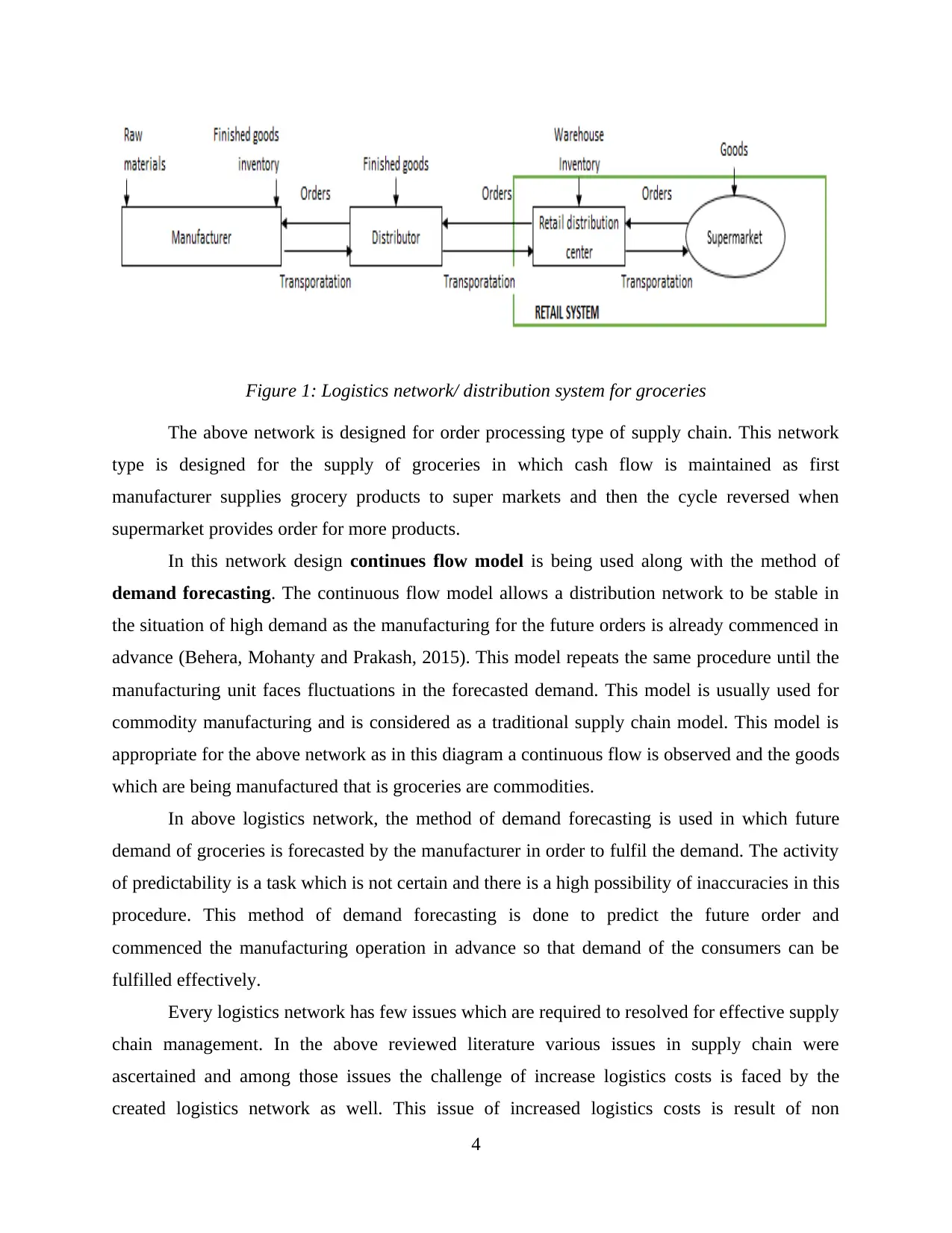
Figure 1: Logistics network/ distribution system for groceries
The above network is designed for order processing type of supply chain. This network
type is designed for the supply of groceries in which cash flow is maintained as first
manufacturer supplies grocery products to super markets and then the cycle reversed when
supermarket provides order for more products.
In this network design continues flow model is being used along with the method of
demand forecasting. The continuous flow model allows a distribution network to be stable in
the situation of high demand as the manufacturing for the future orders is already commenced in
advance (Behera, Mohanty and Prakash, 2015). This model repeats the same procedure until the
manufacturing unit faces fluctuations in the forecasted demand. This model is usually used for
commodity manufacturing and is considered as a traditional supply chain model. This model is
appropriate for the above network as in this diagram a continuous flow is observed and the goods
which are being manufactured that is groceries are commodities.
In above logistics network, the method of demand forecasting is used in which future
demand of groceries is forecasted by the manufacturer in order to fulfil the demand. The activity
of predictability is a task which is not certain and there is a high possibility of inaccuracies in this
procedure. This method of demand forecasting is done to predict the future order and
commenced the manufacturing operation in advance so that demand of the consumers can be
fulfilled effectively.
Every logistics network has few issues which are required to resolved for effective supply
chain management. In the above reviewed literature various issues in supply chain were
ascertained and among those issues the challenge of increase logistics costs is faced by the
created logistics network as well. This issue of increased logistics costs is result of non
4
The above network is designed for order processing type of supply chain. This network
type is designed for the supply of groceries in which cash flow is maintained as first
manufacturer supplies grocery products to super markets and then the cycle reversed when
supermarket provides order for more products.
In this network design continues flow model is being used along with the method of
demand forecasting. The continuous flow model allows a distribution network to be stable in
the situation of high demand as the manufacturing for the future orders is already commenced in
advance (Behera, Mohanty and Prakash, 2015). This model repeats the same procedure until the
manufacturing unit faces fluctuations in the forecasted demand. This model is usually used for
commodity manufacturing and is considered as a traditional supply chain model. This model is
appropriate for the above network as in this diagram a continuous flow is observed and the goods
which are being manufactured that is groceries are commodities.
In above logistics network, the method of demand forecasting is used in which future
demand of groceries is forecasted by the manufacturer in order to fulfil the demand. The activity
of predictability is a task which is not certain and there is a high possibility of inaccuracies in this
procedure. This method of demand forecasting is done to predict the future order and
commenced the manufacturing operation in advance so that demand of the consumers can be
fulfilled effectively.
Every logistics network has few issues which are required to resolved for effective supply
chain management. In the above reviewed literature various issues in supply chain were
ascertained and among those issues the challenge of increase logistics costs is faced by the
created logistics network as well. This issue of increased logistics costs is result of non
4
⊘ This is a preview!⊘
Do you want full access?
Subscribe today to unlock all pages.

Trusted by 1+ million students worldwide
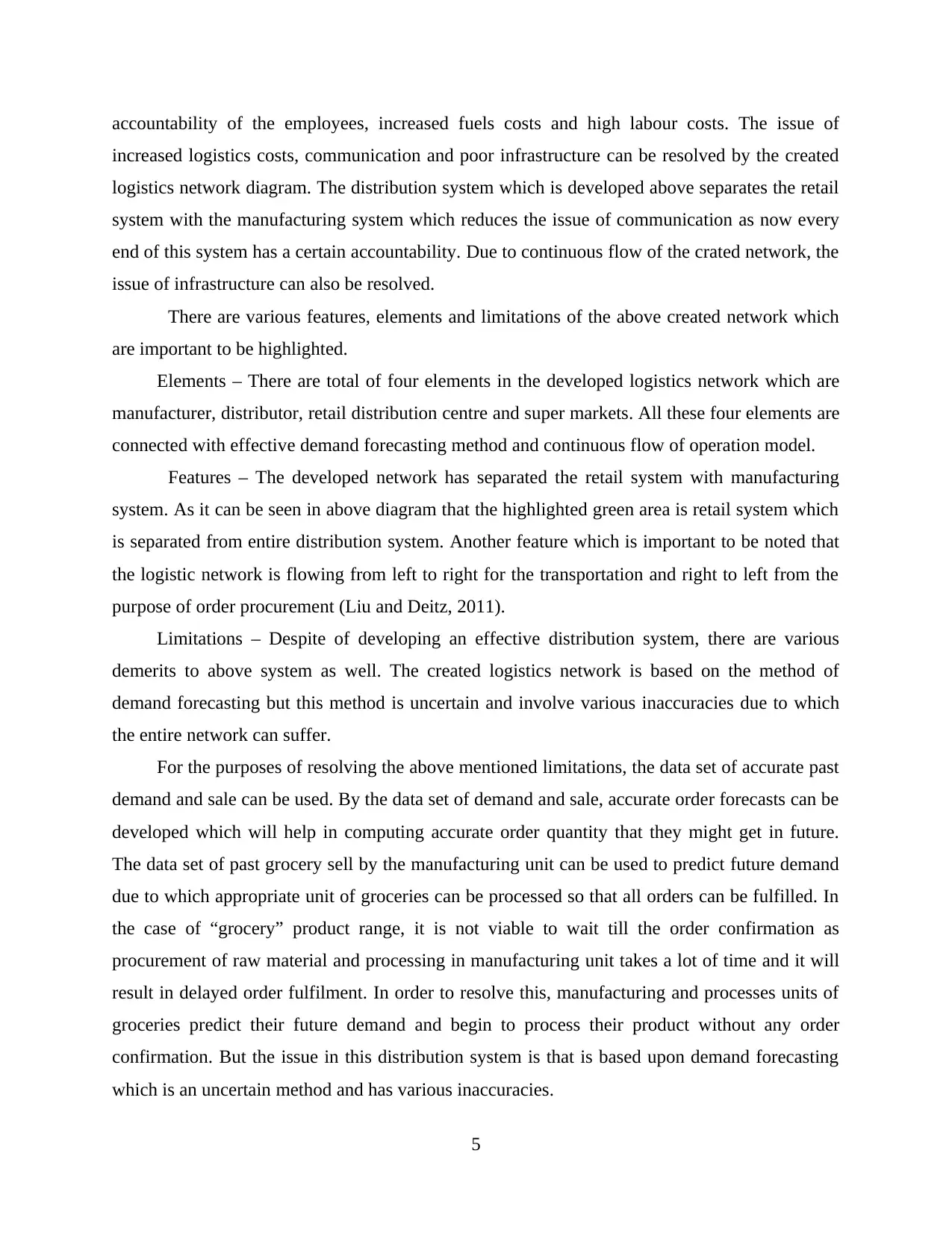
accountability of the employees, increased fuels costs and high labour costs. The issue of
increased logistics costs, communication and poor infrastructure can be resolved by the created
logistics network diagram. The distribution system which is developed above separates the retail
system with the manufacturing system which reduces the issue of communication as now every
end of this system has a certain accountability. Due to continuous flow of the crated network, the
issue of infrastructure can also be resolved.
There are various features, elements and limitations of the above created network which
are important to be highlighted.
Elements – There are total of four elements in the developed logistics network which are
manufacturer, distributor, retail distribution centre and super markets. All these four elements are
connected with effective demand forecasting method and continuous flow of operation model.
Features – The developed network has separated the retail system with manufacturing
system. As it can be seen in above diagram that the highlighted green area is retail system which
is separated from entire distribution system. Another feature which is important to be noted that
the logistic network is flowing from left to right for the transportation and right to left from the
purpose of order procurement (Liu and Deitz, 2011).
Limitations – Despite of developing an effective distribution system, there are various
demerits to above system as well. The created logistics network is based on the method of
demand forecasting but this method is uncertain and involve various inaccuracies due to which
the entire network can suffer.
For the purposes of resolving the above mentioned limitations, the data set of accurate past
demand and sale can be used. By the data set of demand and sale, accurate order forecasts can be
developed which will help in computing accurate order quantity that they might get in future.
The data set of past grocery sell by the manufacturing unit can be used to predict future demand
due to which appropriate unit of groceries can be processed so that all orders can be fulfilled. In
the case of “grocery” product range, it is not viable to wait till the order confirmation as
procurement of raw material and processing in manufacturing unit takes a lot of time and it will
result in delayed order fulfilment. In order to resolve this, manufacturing and processes units of
groceries predict their future demand and begin to process their product without any order
confirmation. But the issue in this distribution system is that is based upon demand forecasting
which is an uncertain method and has various inaccuracies.
5
increased logistics costs, communication and poor infrastructure can be resolved by the created
logistics network diagram. The distribution system which is developed above separates the retail
system with the manufacturing system which reduces the issue of communication as now every
end of this system has a certain accountability. Due to continuous flow of the crated network, the
issue of infrastructure can also be resolved.
There are various features, elements and limitations of the above created network which
are important to be highlighted.
Elements – There are total of four elements in the developed logistics network which are
manufacturer, distributor, retail distribution centre and super markets. All these four elements are
connected with effective demand forecasting method and continuous flow of operation model.
Features – The developed network has separated the retail system with manufacturing
system. As it can be seen in above diagram that the highlighted green area is retail system which
is separated from entire distribution system. Another feature which is important to be noted that
the logistic network is flowing from left to right for the transportation and right to left from the
purpose of order procurement (Liu and Deitz, 2011).
Limitations – Despite of developing an effective distribution system, there are various
demerits to above system as well. The created logistics network is based on the method of
demand forecasting but this method is uncertain and involve various inaccuracies due to which
the entire network can suffer.
For the purposes of resolving the above mentioned limitations, the data set of accurate past
demand and sale can be used. By the data set of demand and sale, accurate order forecasts can be
developed which will help in computing accurate order quantity that they might get in future.
The data set of past grocery sell by the manufacturing unit can be used to predict future demand
due to which appropriate unit of groceries can be processed so that all orders can be fulfilled. In
the case of “grocery” product range, it is not viable to wait till the order confirmation as
procurement of raw material and processing in manufacturing unit takes a lot of time and it will
result in delayed order fulfilment. In order to resolve this, manufacturing and processes units of
groceries predict their future demand and begin to process their product without any order
confirmation. But the issue in this distribution system is that is based upon demand forecasting
which is an uncertain method and has various inaccuracies.
5
Paraphrase This Document
Need a fresh take? Get an instant paraphrase of this document with our AI Paraphraser
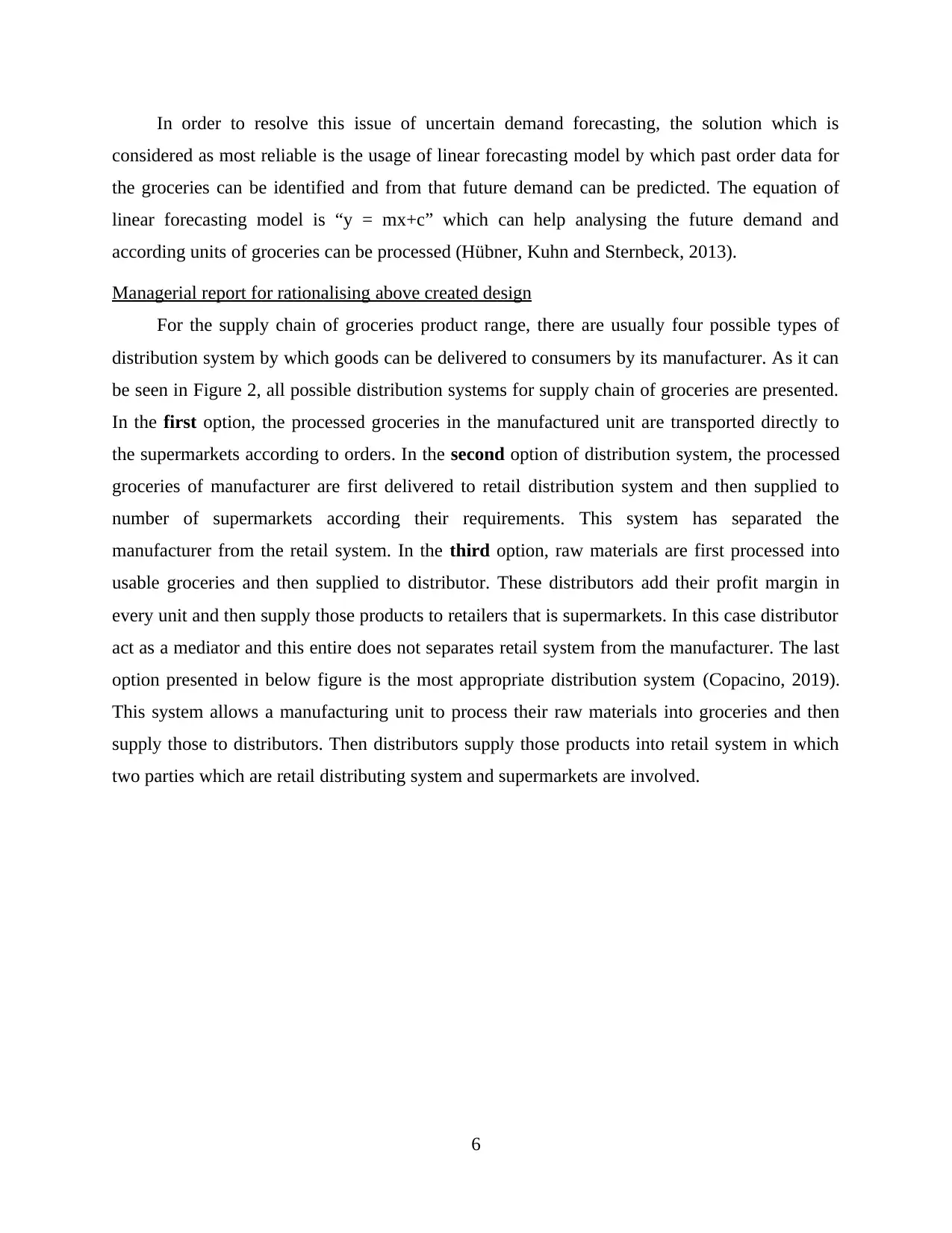
In order to resolve this issue of uncertain demand forecasting, the solution which is
considered as most reliable is the usage of linear forecasting model by which past order data for
the groceries can be identified and from that future demand can be predicted. The equation of
linear forecasting model is “y = mx+c” which can help analysing the future demand and
according units of groceries can be processed (Hübner, Kuhn and Sternbeck, 2013).
Managerial report for rationalising above created design
For the supply chain of groceries product range, there are usually four possible types of
distribution system by which goods can be delivered to consumers by its manufacturer. As it can
be seen in Figure 2, all possible distribution systems for supply chain of groceries are presented.
In the first option, the processed groceries in the manufactured unit are transported directly to
the supermarkets according to orders. In the second option of distribution system, the processed
groceries of manufacturer are first delivered to retail distribution system and then supplied to
number of supermarkets according their requirements. This system has separated the
manufacturer from the retail system. In the third option, raw materials are first processed into
usable groceries and then supplied to distributor. These distributors add their profit margin in
every unit and then supply those products to retailers that is supermarkets. In this case distributor
act as a mediator and this entire does not separates retail system from the manufacturer. The last
option presented in below figure is the most appropriate distribution system (Copacino, 2019).
This system allows a manufacturing unit to process their raw materials into groceries and then
supply those to distributors. Then distributors supply those products into retail system in which
two parties which are retail distributing system and supermarkets are involved.
6
considered as most reliable is the usage of linear forecasting model by which past order data for
the groceries can be identified and from that future demand can be predicted. The equation of
linear forecasting model is “y = mx+c” which can help analysing the future demand and
according units of groceries can be processed (Hübner, Kuhn and Sternbeck, 2013).
Managerial report for rationalising above created design
For the supply chain of groceries product range, there are usually four possible types of
distribution system by which goods can be delivered to consumers by its manufacturer. As it can
be seen in Figure 2, all possible distribution systems for supply chain of groceries are presented.
In the first option, the processed groceries in the manufactured unit are transported directly to
the supermarkets according to orders. In the second option of distribution system, the processed
groceries of manufacturer are first delivered to retail distribution system and then supplied to
number of supermarkets according their requirements. This system has separated the
manufacturer from the retail system. In the third option, raw materials are first processed into
usable groceries and then supplied to distributor. These distributors add their profit margin in
every unit and then supply those products to retailers that is supermarkets. In this case distributor
act as a mediator and this entire does not separates retail system from the manufacturer. The last
option presented in below figure is the most appropriate distribution system (Copacino, 2019).
This system allows a manufacturing unit to process their raw materials into groceries and then
supply those to distributors. Then distributors supply those products into retail system in which
two parties which are retail distributing system and supermarkets are involved.
6
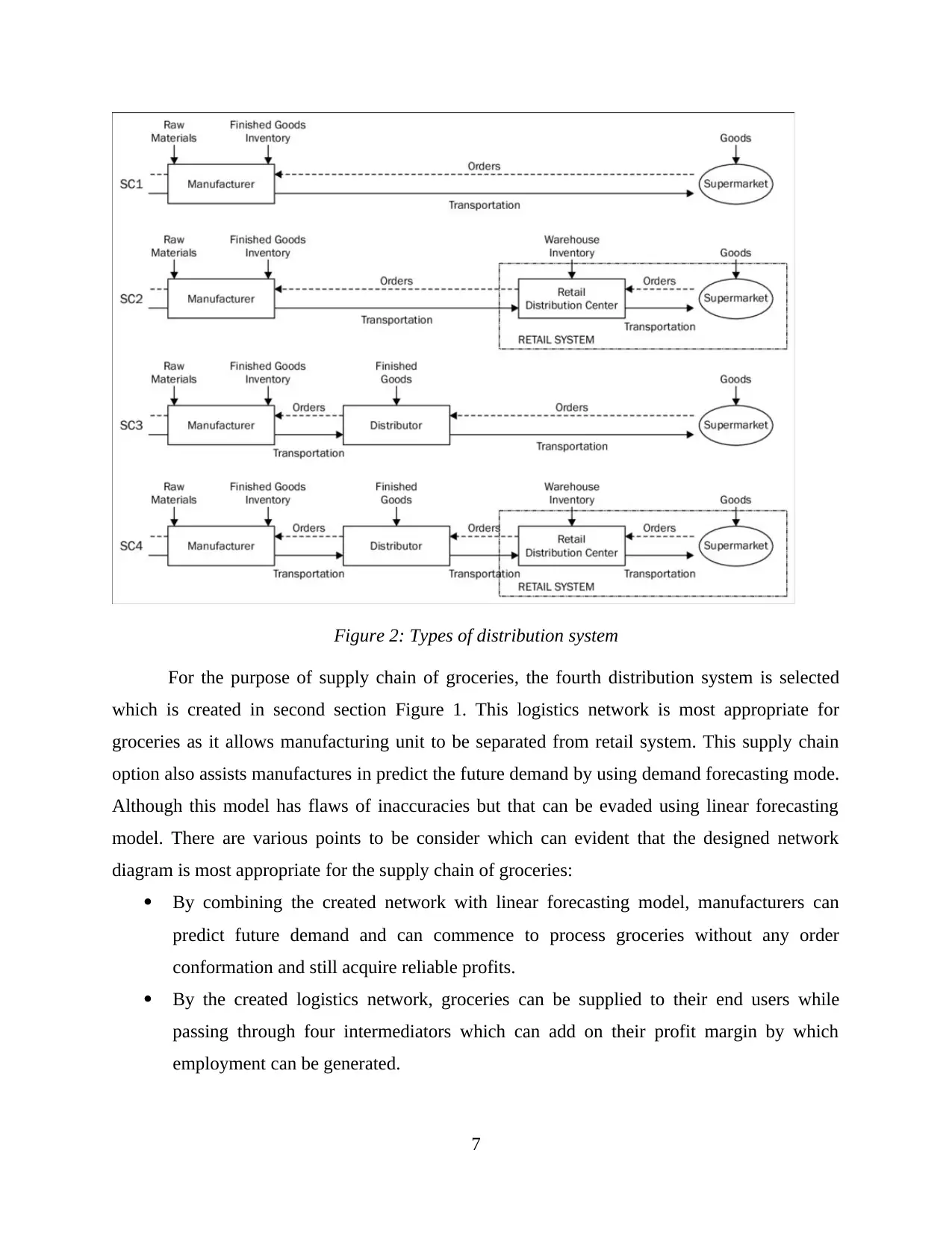
Figure 2: Types of distribution system
For the purpose of supply chain of groceries, the fourth distribution system is selected
which is created in second section Figure 1. This logistics network is most appropriate for
groceries as it allows manufacturing unit to be separated from retail system. This supply chain
option also assists manufactures in predict the future demand by using demand forecasting mode.
Although this model has flaws of inaccuracies but that can be evaded using linear forecasting
model. There are various points to be consider which can evident that the designed network
diagram is most appropriate for the supply chain of groceries:
By combining the created network with linear forecasting model, manufacturers can
predict future demand and can commence to process groceries without any order
conformation and still acquire reliable profits.
By the created logistics network, groceries can be supplied to their end users while
passing through four intermediators which can add on their profit margin by which
employment can be generated.
7
For the purpose of supply chain of groceries, the fourth distribution system is selected
which is created in second section Figure 1. This logistics network is most appropriate for
groceries as it allows manufacturing unit to be separated from retail system. This supply chain
option also assists manufactures in predict the future demand by using demand forecasting mode.
Although this model has flaws of inaccuracies but that can be evaded using linear forecasting
model. There are various points to be consider which can evident that the designed network
diagram is most appropriate for the supply chain of groceries:
By combining the created network with linear forecasting model, manufacturers can
predict future demand and can commence to process groceries without any order
conformation and still acquire reliable profits.
By the created logistics network, groceries can be supplied to their end users while
passing through four intermediators which can add on their profit margin by which
employment can be generated.
7
⊘ This is a preview!⊘
Do you want full access?
Subscribe today to unlock all pages.

Trusted by 1+ million students worldwide
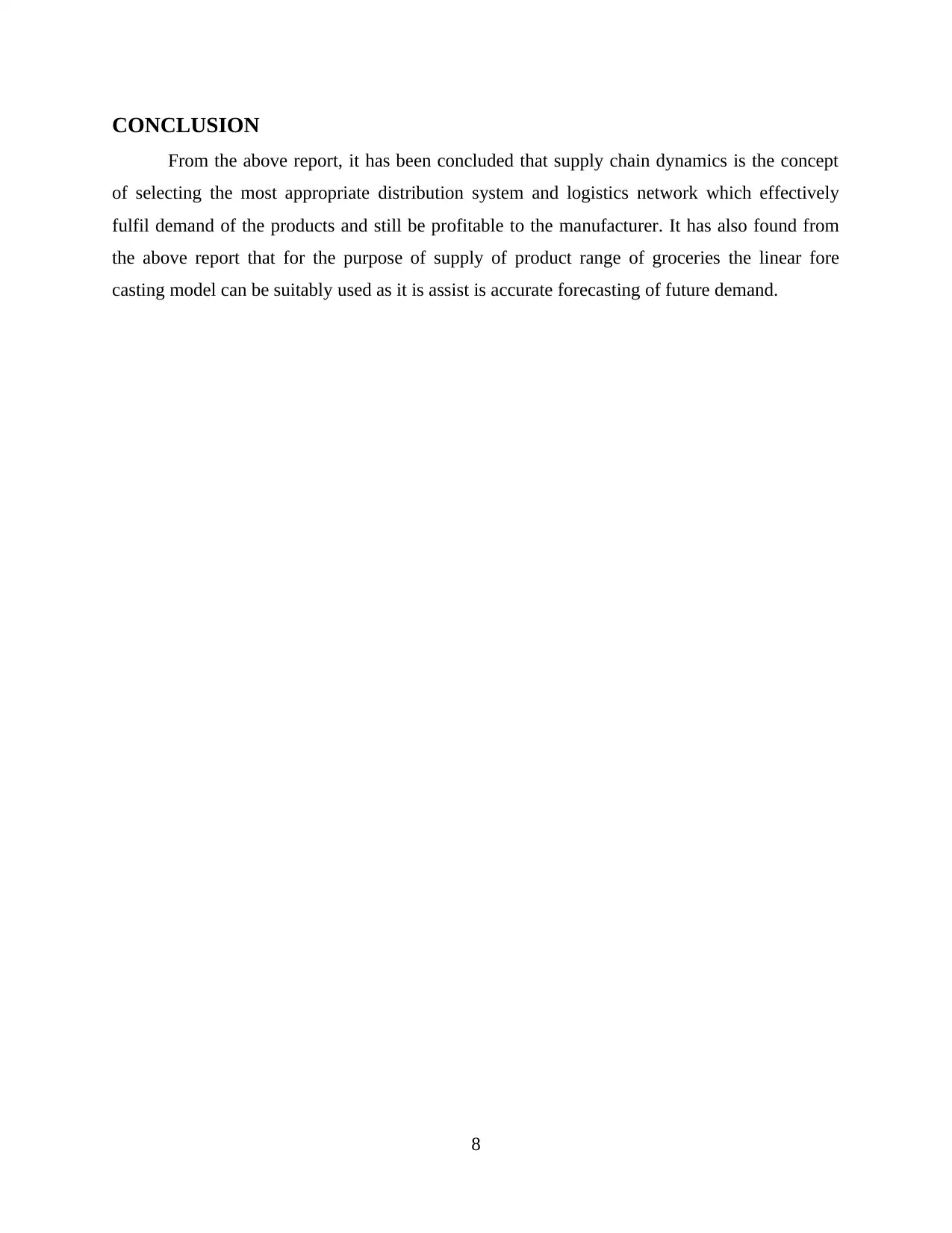
CONCLUSION
From the above report, it has been concluded that supply chain dynamics is the concept
of selecting the most appropriate distribution system and logistics network which effectively
fulfil demand of the products and still be profitable to the manufacturer. It has also found from
the above report that for the purpose of supply of product range of groceries the linear fore
casting model can be suitably used as it is assist is accurate forecasting of future demand.
8
From the above report, it has been concluded that supply chain dynamics is the concept
of selecting the most appropriate distribution system and logistics network which effectively
fulfil demand of the products and still be profitable to the manufacturer. It has also found from
the above report that for the purpose of supply of product range of groceries the linear fore
casting model can be suitably used as it is assist is accurate forecasting of future demand.
8
Paraphrase This Document
Need a fresh take? Get an instant paraphrase of this document with our AI Paraphraser
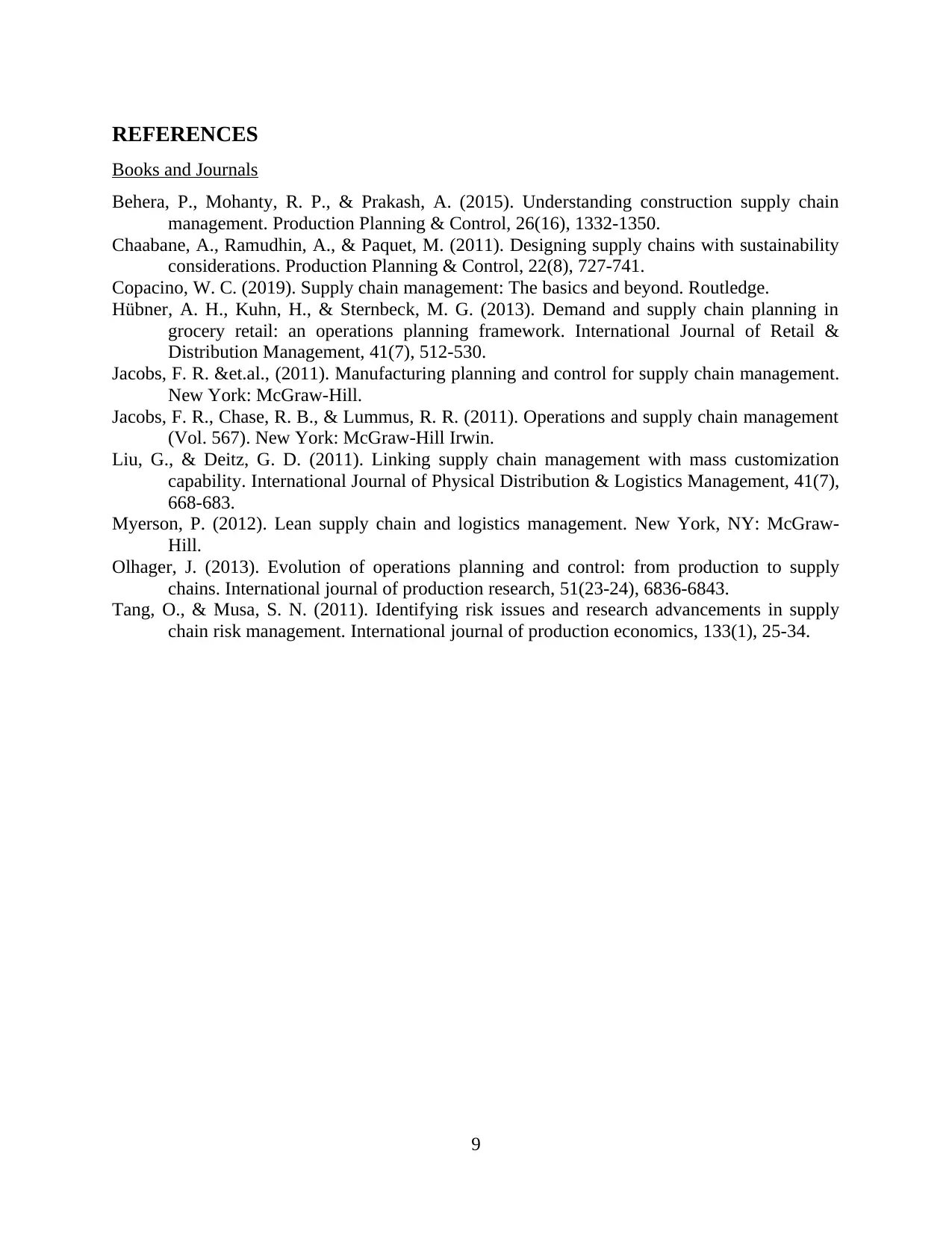
REFERENCES
Books and Journals
Behera, P., Mohanty, R. P., & Prakash, A. (2015). Understanding construction supply chain
management. Production Planning & Control, 26(16), 1332-1350.
Chaabane, A., Ramudhin, A., & Paquet, M. (2011). Designing supply chains with sustainability
considerations. Production Planning & Control, 22(8), 727-741.
Copacino, W. C. (2019). Supply chain management: The basics and beyond. Routledge.
Hübner, A. H., Kuhn, H., & Sternbeck, M. G. (2013). Demand and supply chain planning in
grocery retail: an operations planning framework. International Journal of Retail &
Distribution Management, 41(7), 512-530.
Jacobs, F. R. &et.al., (2011). Manufacturing planning and control for supply chain management.
New York: McGraw-Hill.
Jacobs, F. R., Chase, R. B., & Lummus, R. R. (2011). Operations and supply chain management
(Vol. 567). New York: McGraw-Hill Irwin.
Liu, G., & Deitz, G. D. (2011). Linking supply chain management with mass customization
capability. International Journal of Physical Distribution & Logistics Management, 41(7),
668-683.
Myerson, P. (2012). Lean supply chain and logistics management. New York, NY: McGraw-
Hill.
Olhager, J. (2013). Evolution of operations planning and control: from production to supply
chains. International journal of production research, 51(23-24), 6836-6843.
Tang, O., & Musa, S. N. (2011). Identifying risk issues and research advancements in supply
chain risk management. International journal of production economics, 133(1), 25-34.
9
Books and Journals
Behera, P., Mohanty, R. P., & Prakash, A. (2015). Understanding construction supply chain
management. Production Planning & Control, 26(16), 1332-1350.
Chaabane, A., Ramudhin, A., & Paquet, M. (2011). Designing supply chains with sustainability
considerations. Production Planning & Control, 22(8), 727-741.
Copacino, W. C. (2019). Supply chain management: The basics and beyond. Routledge.
Hübner, A. H., Kuhn, H., & Sternbeck, M. G. (2013). Demand and supply chain planning in
grocery retail: an operations planning framework. International Journal of Retail &
Distribution Management, 41(7), 512-530.
Jacobs, F. R. &et.al., (2011). Manufacturing planning and control for supply chain management.
New York: McGraw-Hill.
Jacobs, F. R., Chase, R. B., & Lummus, R. R. (2011). Operations and supply chain management
(Vol. 567). New York: McGraw-Hill Irwin.
Liu, G., & Deitz, G. D. (2011). Linking supply chain management with mass customization
capability. International Journal of Physical Distribution & Logistics Management, 41(7),
668-683.
Myerson, P. (2012). Lean supply chain and logistics management. New York, NY: McGraw-
Hill.
Olhager, J. (2013). Evolution of operations planning and control: from production to supply
chains. International journal of production research, 51(23-24), 6836-6843.
Tang, O., & Musa, S. N. (2011). Identifying risk issues and research advancements in supply
chain risk management. International journal of production economics, 133(1), 25-34.
9
1 out of 11
Related Documents
Your All-in-One AI-Powered Toolkit for Academic Success.
+13062052269
info@desklib.com
Available 24*7 on WhatsApp / Email
![[object Object]](/_next/static/media/star-bottom.7253800d.svg)
Unlock your academic potential
Copyright © 2020–2025 A2Z Services. All Rights Reserved. Developed and managed by ZUCOL.




